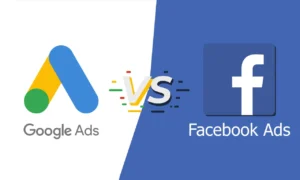In the fast-paced world of digital advertising, two juggernauts stand out: Google Ads and Facebook Ads. As a digital marketing agency navigating the dynamic landscape of online promotion, understanding the nuances and advantages of each platform is crucial for maximizing your clients’ ROI. Let’s dive into the intricate realm of Google Ads versus Facebook Ads, exploring their unique features, target audience reach, and effectiveness in driving conversions.
1. Targeting Options:
Google Ads, powered by the omnipresent Google search engine, offers advertisers a wealth of targeting options based on keywords, location, device, demographics, and even user behavior. This precision targeting ensures that your ads reach users actively searching for relevant products or services, leading to higher conversion rates.
On the other hand, Facebook Ads leverage the social media giant’s extensive user data to target audiences based on demographics, interests, behaviors, and connections. With advanced targeting capabilities, advertisers can tailor their ads to specific segments of the population, making Facebook Ads particularly effective for brand awareness campaigns and reaching niche audiences.
2. Ad Formats:
Google Ads provide a variety of ad formats, including search ads, display ads, video ads, shopping ads, and app promotion ads. Each format serves a unique purpose, allowing advertisers to engage with their target audience at different stages of the customer journey. For instance, search ads capture users actively searching for products or services, while display ads create brand awareness and reach potential customers browsing relevant websites.
Facebook Ads, on the other hand, offer a wide range of ad formats such as image ads, video ads, carousel ads, slideshow ads, and collection ads. These visually appealing formats are seamlessly integrated into users’ news feeds, enabling advertisers to capture attention and drive engagement. Additionally, Facebook’s immersive ad formats, such as augmented reality ads, provide interactive experiences that enhance brand recall and user engagement.
3. Cost and ROI:
When it comes to cost-effectiveness, both Google Ads and Facebook Ads offer flexible pricing models, including cost-per-click (CPC), cost-per-mille (CPM), and cost-per-action (CPA). The cost of advertising on each platform depends on various factors such as competition, targeting options, ad relevance, and bidding strategy.
Google Ads typically have a higher CPC compared to Facebook Ads, especially for competitive keywords and industries. However, Google Ads often yield higher conversion rates due to the intent-driven nature of search advertising. On the other hand, Facebook Ads offer a lower CPC on average but may require a higher volume of impressions to generate conversions. Ultimately, the ROI of each platform depends on the specific goals, target audience, and effectiveness of ad campaigns.
4. Audience Intent:
One of the key distinctions between Google Ads and Facebook Ads lies in audience intent. Google Ads target users with high commercial intent, i.e., individuals actively searching for products or services, indicating a higher likelihood of conversion. This makes Google Ads ideal for capturing potential customers at the moment of purchase consideration, driving direct response and sales.
In contrast, Facebook Ads target users based on their interests, behaviors, and social interactions, rather than explicit search queries. While this allows advertisers to reach a broader audience and create brand awareness, it may not always translate into immediate conversions. Facebook Ads are more effective for building brand affinity, fostering engagement, and nurturing leads over time through targeted content and storytelling.
Conclusion:
In the eternal battle of Google Ads vs Facebook Ads, there is no one-size-fits-all answer. Both platforms offer distinct advantages and cater to different advertising objectives, target audiences, and stages of the customer journey. As a digital marketing agency, understanding the strengths and weaknesses of each platform is essential for crafting tailored advertising strategies that drive results for your clients.
Whether you’re looking to capture high-intent users actively searching for your client’s products or services or engage with a broader audience and build brand awareness, leveraging the unique features and capabilities of Google Ads and Facebook Ads can help you achieve your advertising goals effectively. By strategically combining the power of both platforms and continuously optimizing your campaigns based on data-driven insights, you can unlock the full potential of digital advertising and deliver exceptional results for your clients.




